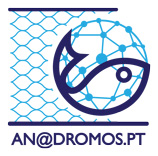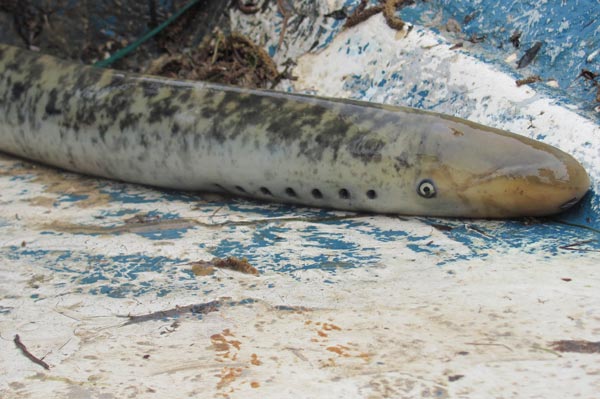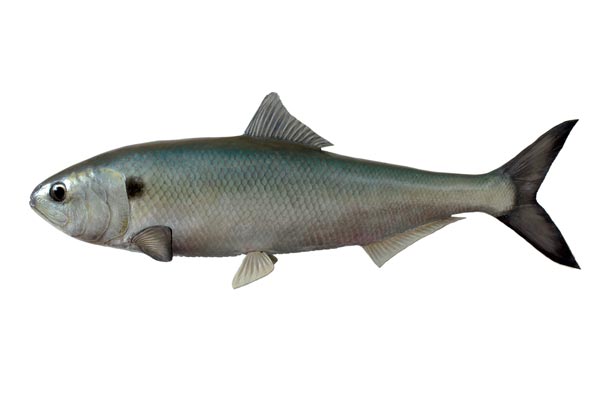MIGRATORY SPECIES
Of the over 32 000 known fish species, 58% live in the sea, 41% in freshwater and less than 1% use both ecosystems during their lifetime, which are known as diadromous species. The word diadromous came from the ancient Greek and it’s composed by two words “Dia” and “Dromos” meaning “through” and “running”. In other words, anadromous fish “run”, i.e. migrate, through distinct ecosystems, freshwater of rivers and saltwater of the sea.
- Anadromous Migrator (from Greek “Ana”, “up”): Diadromous species with a feeding and growing stage at sea before adults migrate to the rivers to reproduce (e.g. salmon, sea lamprey, shads and sturgeon);
- Catadromous Migrator (from Greek “Cata”, “down”): Diadromous species with a feeding and growing stage at rivers before migrating to sea to reproduce (e.g. European eel, mullet and rock flounder).
Of all threats to diadromous fish survival in continental aquatic ecosystems, due to their particularly lifecycle and according to the high commercial value that some of these species can achieve, the ones contributing the most to stock depletion are: i) continual longitudinal interruption and habitat loss due to dam and weir construction; ii) overfishing and furtive activities.
Sea lamprey and shads are generally distributed through all major national river basins, being more abundant in the central and northern part of the country. On the other hand, Atlantic salmon and trout occur mainly at the North part of the country, especially at Minho and Lima rivers.
Sea lamprey, Petromyzon marinus L.
Conservation status in Portugal: Vulnerable (VU).
Adults live in the ocean, migrating to rivers to reproduce. For this they prefer areas of high abundance of pebbles, gravel and sand. Larvae live buried in the sandy riverbed and prefer shallow areas, with weak currents and shadowed waters. Larvae are filters, but adults are parasites and feed off the blood of other fish. Adults don’t feed during reproductive migration. This species occurs in the main basins north of the Sado river and, although less abundant, in the Guadiana river basin. It begins its reproductive migration in December, which peaks between February and April. It is a semelparous species – it reproduces only once during its entire lifecycle, dying after spawning. Obstacles to migration, consequent loss of habitat, and overfishing – including poaching activities – are the main threats this species faces in national territory.
Allis shad, Alosa alosa, L.
Conservation status in Portugal: Endangered (EN).
Pelagic species that occupies the water column during its period in marine habitat. Its spawning habitat can be characterized by a succession of both deep, slow current areas, and shallower, fast current areas. It occurs in rivers Minho, Lima, Cávado, Douro, Vouga, Mondego, Tejo and Guadiana. Its upstream migration to rivers begins in February and the reproduction occurs until June. Most of these fish die after spawning. It is a planktivore species, and it doesn’t feed during reproductive migration. Loss of longitudinal connectivity within water courses and overfishing are the main threats to this species.
Twaite shad, Alosa fallax (Lacepède, 1803)
Conservation status in Portugal: Vulnerable (VU).
Like its congener, this species is pelagic. However, the preferred spawning habitat differs, as this species remains downstream, in the lower section of the rivers. It occurs in the basins of rivers Minho, Lima, Cávado, Douro, Vouga, Mondego, Tejo, Sado, Mira and Guadiana. It’s distinguishable from allis shad by its smaller size and by the presence of 4 to 8 dark spots in its dorso. Species upstream migration to rivers begins in February and it can reproduce until June. It is mainly planktivore, but it can occasionally feed on smaller fish. During reproductive migration, adults don’t feed. Like the allis shad, longitudinal connectivity within river basins and overfishing are the main threats the species faces.
Atlantic salmon, Salmo salar L.
Conservation status in Portugal: Critically Endangered (CR).
A benthopelagic species, distributed throughout all the north Atlantic. In national territory it occurs mainly in the rivers Minho and Lima. Male mandibles display a more pronounced curvature before and after reproduction. After hatching, this species usually lives 1 to 2 years in fresh water, period after which it begins its downstream migration towards the ocean. During this migration, in estuarine waters, the fish begin a transformation process known as smoltification, in which it acquires a silver hue and adaptions to a maritime environment. It spends the winter in the ocean and then return to their hatch area to spawn. Contrary to its Pacific congenial, the Atlantic salmon can reproduce more than once.
In Portugal it is estimated that its effective population is too low to be considered a viable resource for commercial exploration, which increases its conservational interest.
Sea trout, Salmo trutta L.
Conservation status in Portugal: Critically Endangered (CR).
Like the Atlantic salmon, it is a benthopelagic species distributed in the north Atlantic, and it occurs in national territory mostly in the rivers Minho and Lima, but also in Cávado, Douro, Vouga and Mondego. It is easily mistaken with its congener Salmo salar, its superior maxilla being a distinctive factor, as it is more prolonged and can extend past the posterior edge of the eye. It also displays an adipose fin with a red margin. This species can present two distinctive forms: (i) Holobiotic – spends its entire life cycle in freshwaters and can be distinguished from amphibiotic form by its brownish colour with light reddish-centred patches; and (ii) Amphibiotic – anadromous migrator, it also undergoes a smotification process, adapting to life on the ocean, where it reaches its adults phase and sexual maturity, upon which it returns river basins to spawn. Can be distinguished from holobiotic form by its silver colour and dark patches.
Like the salmon, its effective population is estimated to be too low to be considered a viable resource for commercial exploration. Both species are significantly produced in aquaculture, being that only the trout, especially its holobiotic form, the brown trout, is cultivated for commercial purposes, in Portugal.






